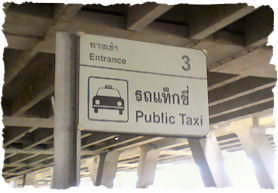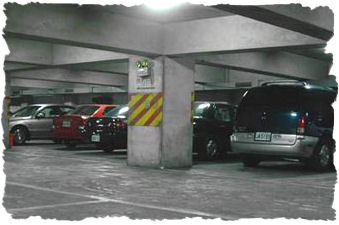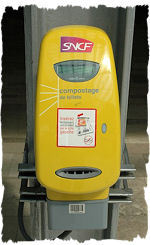|
The IHateTaxis.com Glossary
Here are a few terms and values that we use throughout the site that might need some additional explanation.
Official Taxi
 |
An 'Official' Taxi is one that is authorized to pick-up passengers at an airport. There is quite a bit of variation on what 'official' means between airports. For some developed countries, taxi companies bid on fees with airport authorities to win 'official' status for a contracted period. This status will allow them to be the exclusive company that may provide taxi services from the airport. Unfortunately, this status often translates to higher fares to passengers or minimum fare rules.

Any taxi company is still allowed to drop-off passengers at the airport, but then they must 'dead-head' back to town as they cannot pick-up passengers. In some cities, this also restricts your trip to the airport as well as no other taxi company may have an interest in taking you there as they will return to town without a passenger. You can, however, hire any taxi company unofficially at airports by following the unofficial taxi hiring points procedure, below.
In other airports, 'Official' taxis might be regulated by their licence if they can pick-up passengers at the airport. This might be identified by an 'airport service' logo on the taxi or a special licence plate. Any driver of any taxi with the correct licence may drop-off or pick-up passengers.
Regardless of what the word 'Official' means, there may be an increased level of safety or documental with using an 'Official' taxi, although in some cases it comes as a higher fee or wait time for the passenger.
Pirate Taxi
 |
Pirate Taxis are an illegal form of a taxi. There are variations on this theme from airport to airport, but these can include any of the following:
- A private car, not authorized to transport passengers by both licence and insurance
- A private car with the words TAXI on the side (painted or magnetic sticker), the word TAXI written on a paper stuck to the window, a removable TAXI sign, or absolutely nothing identifying it as a taxi.
- A real taxi, being driven by someone that does not have a licence to transport passengers
 Pirate taxis will never be at the front of the arrivals area of the airport. Typically passengers are taken to a parking location or a tout will call for the pirate taxi on a radio or mobile phone and then a car will appear in the arrivals area. If you are lead away from the arrivals area, especially to a carpark/parking lot, then this likely is a pirate taxi!
We never recommend pirate taxis as there is a degree of risk associated with taking them. You will never save money by taking a pirate taxi and if the fare seems a little too cheap, expect some other sort of game to be played during your ride.
Note that at some small airports in remote locations with limited service, there may be no taxi service, but people just use regular cars to get around. If in doubt, ask at your destination.
Unofficial Taxi or Official Taxi from an Unofficial Hire Point
 |
Taxis that are hired from unofficial hiring points are those that are authorized to drop-off (and possibly, but not necessarily, authorized to pick-up a.k.a. 'Official Taxis') at the airport, but you attempt to hire them to take you to town from an 'unofficial' location. Hiring from unofficial locations may bypass a long official queue for taxis and possibly a fee associated with that queue. The downside is that there possibly will be no record of you taking the taxi should anything go wrong and there might be some language issues as usually an official queue will have someone that speaks a little bit of English for translating to the taxi driver. Unofficial hire points may also get you a cheaper fare, but sometimes you increase your chances of being ripped off. Many taxi drivers prefer the unofficial hire point as they have less time to wait for passengers and sometimes avoid paying fees. Some airport authorities will discourage unofficial hire points in the airport grounds. Typical unofficial locations include:
- The departure gates (where passengers are dropped-off)
- Back of the official taxi lineup (essentially queue jumping)
- Just beyond the departure gates, especially in cases where airport authorities enforce taxi rules about not allowing passengers to hire taxis at the departure gates
- On the road leading to the arrival gates, allowing the driver to avoid the queue
In some locations where airport authorities strongly enforce the rules for taxis, drivers themselves will deny hiring of their taxi at unofficial locations. We sometimes do recommend using an unofficial hiring point, but there are potentially some risks with using an unofficial hire location.
Airport Shuttle
For most airports that offer an 'Airport Shuttle' service, this typically is anything from a large van to a medium or regular-sized bus that has extra storage for luggage, either in the front or back of the shuttle. Shuttles may depart at specific times or when they are full. Shuttles typically run to select hotels in the downtown area, although you may always ask for a specific drop-off location if it is on-route and drivers are usually quite accommodating if they can legally make the stop. Airport Shuttles almost always need to be booked for the return trip to the airport.
In some cities, the airport shuttle services offer deep discounts to passengers traveling together as they are competing with the taxi service. Usually for single passengers the airport shuttle will be cheaper, but the time to get to your destination will be longer.
Public and Private Buses
 |
In many countries there is quite a variation on what 'public' and 'private' bus service means. In some locations the buses are privately-owned, but fares are government-regulated, which leads to even more confusion. We have tried to separate the two based on these loose criteria:
- A public bus is one that runs a specific route, is almost always identified by a number, and the payment is always in cash, tokens, or bus tickets. There is generally no accommodation for luggage, nor any guarantee of a seat. You ring a bell or tell the bus driver where you want to get off the bus.
- A private bus may run a specific route or go to a specific place (such as a bus station), possibly with stops. It might be privately-owned or publicly-owned. There is always space accommodation for luggage, usually below the bus. Payment usually is by cash or credit card, via a ticket-counter. Rarely do you pay the driver directly. You are always guaranteed a seat. Private buses are always more expensive than public buses.
Trains and Subways
 |
Trains and Subways are very similar, so we have tried to separate them based on some loose criteria. Generally only in Europe will you come across both in the same airport. We have tried to separate the two based on these criteria:
- A train is more for long distance commuting, with your destination some distance away. Trains run above ground, except possibly in urban areas. There is generally more room on a train and sometimes there are services like a bar or luggage storage area. There likely is multiple classes on board, indicated with a number outside the train (e.g., '1', '2', '3'). You may be assigned a specific seat in a specific car.
- A subway is a public commuting system, with regular stations located a few minutes apart. There are no services on board and there is usually no space for luggage, except between your feet or on the seat next to you if it is not too full. Subways are almost always single class and you are never assigned a seat. Subways may run above or below ground.

Note that many train and subway services have self-validation machines. You purchase a ticket, token, or pass and then find a box to validate it. Some validation boxes, especially those on subway systems, will open a gate when validated. Train systems may just have a box on the platform to validate (typically yellow or orange), so make sure to validate prior to boarding. Failure to validate a ticket will lead to fines if you are caught and having a ticket that is not validated is the same as not having a ticket. Ask if you cannot find out how to validate your ticket. Some trains do still have conductors that check tickets too.
ALWAYS keep your validated ticket or pass safe and do not loose or damage it. In many locations you will also need to validate it on exit.
Limousine Service
Limousine Service may includes both various forms of limos and executive car services. Executive cars are generally nicer cars and are not marked as a taxi. In some cities the limos/executive cars and taxis complete fiercely and prices might be quite similar.
Metric Time
 |
Throughout IHateTaxis.com, we have used the 24 hour clock system (sometimes referred to as 'metric time' or 'military time') of time as we cater to an international audience. If you are familiar with using a.m. or p.m. for time, this may be easily converted. Outside of North America, you will quite often hear time quoted in a 24 hour system, such as "the shuttle departs at 17:30". Here is an easy conversion table:
| 12 hour | 24 hour |
12 hour | 24 hour |
|---|
 |
| Midnight, 12 a.m. | 00:00 or 24:00 | Noon, 12 p.m. | 12:00 |
| 1 a.m. | 01:00 | 1 p.m. | 13:00 |
| 2 a.m. | 02:00 | 2 p.m. | 14:00 |
| 3 a.m. | 03:00 | 3 p.m. | 15:00 |
| 4 a.m. | 04:00 | 4 p.m. | 16:00 |
| 5 a.m. | 05:00 | 5 p.m. | 17:00 |
| 6 a.m. | 06:00 | 6 p.m. | 18:00 |
| 7 a.m. | 07:00 | 7 p.m. | 19:00 |
| 8 a.m. | 08:00 | 8 p.m. | 20:00 |
| 9 a.m. | 09:00 | 9 p.m. | 21:00 |
| 10 a.m. | 10:00 | 10 p.m. | 22:00 |
| 11 a.m. | 11:00 | 11 p.m. | 23:00 |
Note that midnight may be written as either 00:00 or 24:00, but minutes after midnight always start with '00' (e.g., 00:16). For 'military time', a leading '0' is added to numbers under 10, however sometimes for 24 hour clock format this leading '0' is dropped.
|
|
|
